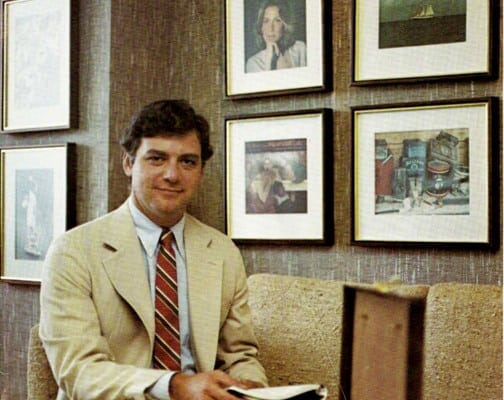
COMSHARE
Ann Arbor’s Highly Successful Computer Based Products & Services Company
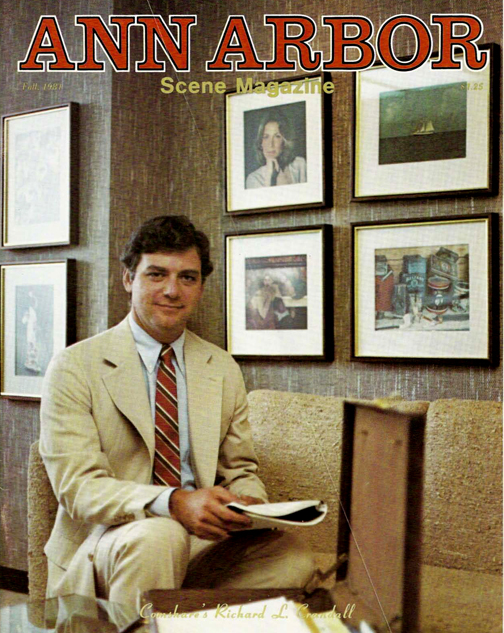
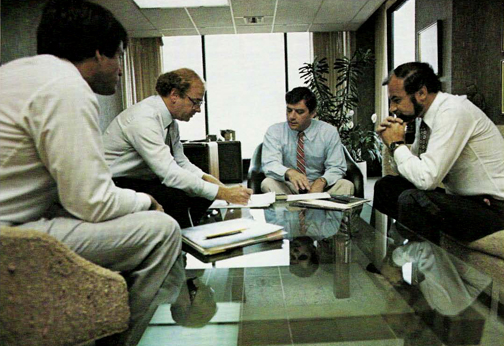
Photo; A meeting of Comshare executives, left to right; Joe Blumberg, Vice-President of Human Resources and Administration; Wally Wrathall, Group Vice·President 0f Finance and Administration; Richard Crandall, President of Comshare; and Kevin Kalkhoven, Group Vice-President.
BY JOHN KILSTROM
Comshare. It is the spirit of Ann Arbor embodied in a progressive, inquisitive and entreprenuerial computer services company.
Progressive, because over its 16-year history, Comshare’s annual revenues have grown to more than $80 million, its employee count in the U.S. from 6 to 900 and its attitude from untested optimism to experienced confidence.
Inquisitive, because by probing the potential of computer technology, it has been partner to some of the most important developments-timesharing, networking and color graphics-in the computer services industry.
Entreprenuerial, because it has beat the odds associated with building a business on technology that is often outdated before it becomes a commercial reality.
Currently, Comshare provides computer-based products and services to thousands of worldwide customers. Clients are served from the headquarters office in Ann Arbor and from 54 field offices in the U.S., Canada, Europe and Japan. They use computer power generated by data centers in Ann Arbor, Chicago, London, Toronto and Tokyo.
About three fourths of Comshare’s clients in the U.S. use the services of anyone or more of Comshare’s specialty groups: Profiles, Parsec, Compass, 4.1.1, and Trust. These groups design, develop, market and support services that address the infonnation needs of specific industries or disciplines.
Profiles is about people management. It is a series of computerized systems that businesses use to organize and analyze information about their employees. Clients use Profiles to build salary administration programs, to gauge their future needs for human resources and to answer government requests for information about their equal opportunity employment performance
Parsec is a set of corporate money management tools. Controllers, budget managers, marketing analysts and others use Parsec systems to analyze, test, forecast and report on the economic variables that affect the business bottom line.
4.1.1 puts computers to work for telephone companies. Both the Bell System and independent phone companies use 4.1.1 systems to keep track of customer line/number assignments, to direct traffic on telephone switches and to provide customers with computerized directory assistance.
Compass is a household name in thousands of certified public accounting offices. Accountants employ Compass systems to do tax planning, auditing, to back up financial advice that they give to their customers and to manage their own internal operations.
Trust Services is tailored 10 banks with trust departments. Bankers from over 300 institutions use Comshare systems to keep records for personal trust accounts, to administer employee benefit plans (like pension programs) and to process corporate tax returns.
But, as President Richard L. Crandall explains, there’s more to Comshare than’ its specialties.
“Right now, Comshare is digesting three major technology milestones in the computer services industry: color graphics, word processing and micro-computers,” he notes. “We’re using those technologies to make computer output more legible, understandable and useful to clients in our specialty markets. It might not sound very critical to say that we have to pretty up our output, but that encompasses an enormous area of potential business for us.”
Execuchart, Comshare’s recently released color business graphics system, is the most outstanding example of the company’s new emphasis all output cosmetics. It produces presentation quality graphics from computer data in 35mm slides, transparencies or paper copies.
By riding the crest of another major milestone in the computer industry the advent of microcomputers-Comshare says it is, again, demonstrating a push to bring computer solutions closer to customer needs.
“We’re taking a something-for-everyone approach,” Crandall states. “That means we’ll offer our specialty products in multiple versions that run on different sizes of computers. Users with big volumes are likely to use our timeshared systems or to run our software on their in-house computers. Users with small volumes are likely to find our minior microcomputers more economical.”
That represents quite an extension of the firm’s original, sole line of business: Computer timesharing. Timesharing kindled the vision that, in 1966, gave six employees of the University of Michigan’s computer center the nerve to take a crack at starting their own computer services business. Crandall was one of those young entrepreneurs.
What did it take to use computers back then? Programming competence, punched cards, patience and a good “in” with the data processing (d.p.) people who operated the machines, Crandall says.
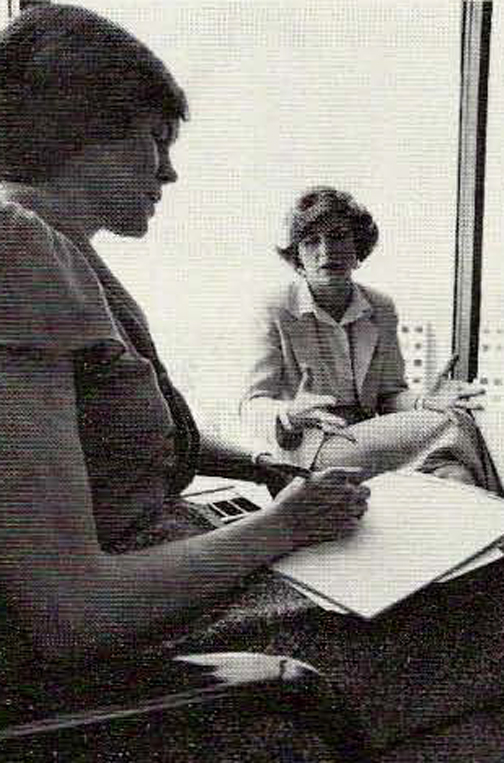
Photo: Linda La Barre, Manager of Marketing for Comshare’s Personnel Services Division, Profiles discusses a proiect with Carol Barnford, left side of photo who is a writer in the Publications Department.
“You had to write your program, get your cards punched, submit them to d.p., wait, get your results, correct your errors, resubmit your cards, and wait again,” Crandall remembers.
“Coming up with timesharing made us feel like white knights. Timesharing hooked users into the computer through telephone lines. It let them do their work on the same machine at the same time, and gave them instant response. It cracked the power structure that had put computers in control of users.”
The crack widened considerably over the next several years as parallel development groups around the country raced with Ann Arbor’s white knights to perfect the technology.
A year and a half later several groups crossed another technology milestone: networking. It was the computer service industry’s quantum leap.
“Networking allows us to run data over specially conditioned telephone lines,” says Crandall. “That lets us deliver our service anywhere, at the right price. Earlier we thought we’d have to open a computer center in every city. To put it mildly, networking was mind blowing.”
It was also revenue producing. Between 1967 and 1969, Comshare revelled in unbridled growth. It grew to 244 employees working in 21 cities using the power of five computer systems. The company went public in 1968. It opened a sister company in Canada in 1969 and another in Europe in 1970. Revenues hit 54 million.
The company’s boom market was the healthy, wealthy aerospace industry. That industry’s engineers had fallen hook, line and sinker for timesharing.
But the aerospace industry hit the skids in the early 1970s and Comshare temporarily lost its footing. The company reported losses of $3.5 million on revenues of $4.8 million in 1970.
By 1972,however, the company was back in the black, reporting what would become the first quarter of ten continuously profitable years. During the twoyear hiatus between paucity and profit, Comshare’s management reassessed its direction and developed a new corporate plan. The plan aimed at cultivating the business, rather than engineering market. It was then that the company embarked on its primary strategy of providing specialized computer services to select industries and disciplines.
Technology cooperated. About that same time-the mid 70s-the computer service industry whistled by another milestone: the development of data management languages. Such languages let users control, store, file, retrieve and analyze vast amounts of information with easy commands and instructions. In doing so, they catapulted business people with little technical background over the intimidating computerese “language barrier” that had kept them from putting computers to productive use.
The development of data management technology paved the way for the birth of true computer “products” standard systems that many firms can use to solve similar infonnation problems. From the mid-70s until today, Comshare’s growth has been based on the development and marketing of those products.
Comshare has maneuvered many strategic twists and turns. But its second longest-term employee, senior computer scientist, Steve Weiss, says that his confidence in the company’s survival never lagged.
“I always expected Comshare to grow, though not the way it did. I thought it would be a great utility like Detroit Edison or Bell Telephone, largely because I didn’t anticipate the development of minis and micros, nor the fierce competition of the 70s,” Weiss says. “Through it all, the spirit of Comshare has been strong. The people who work here take great pride in what they do and in the company.”
What does Comshare do to nurture that kind of attitude? Hints can be found in the management “creeds” followed by the company’s senior executive team: Crandall, Richard Eidswick, Kevin Kalkhoven, Don Devine, Ian McNaught “Mac” Davis (located in England), and Wally Wrathall.
“We believe risk taking begets innovation, progress and growth.. it’s what causes surprising things to happen in a company,” Crandall says. “So we delegate authority broadly and are resilient to a certain amount of failure. We believe that the company should bear the cost of managers stubbing their toes from time to time. Without it, we would not be making aggressive enough decisions. ”
“We also pursue active communications programs that encourage employees to get answers to questions.
“Finally, we have a certain irreverance for bureaucracy. Administration is necessary in a company to guide activity, but it shouldn’t get in people’s way. We’ll tear it down if it does, although I must say that the bigger the company gets, the more administration we seem to need, particularly in today’s highly regulated society.” he concludes.
Crandall is sure that those attitudes help explain Comshare’s success in attracting high caliber people. Nancy Sock, the 364th person to join Comshare’s Ann Arbor staff would tend to agree with him. After just a day with the company, she said, “There’s an atmosphere here that suggests Comshare is a place where people really work together toward goals. It’s informal, cooperative – a company with a sense of humor. I believe that Comshare will continue to go places.”

COMSHARE Company Chronology
| DATE | EVENT |
| 1966 | Comshare established. First among timesharing technology development. |
| 1967 | First users of timesharing, networking technology. U.S. employees: 61 |
| 1968 | Revenue: $1,135,000 U.S. employees: 164 |
| 1969 | Expands to Canada. Toronto data center opens. Revenue: $3,872,000 U.S. employees: 244 |
| 1970 | Expands to Europe. London data center opens. Revenue: $4,879,000 U.S. employees: 179 |
| 1971 | Revenue: $5,280,000 U.S. employees: 158 |
| 1972 | Enters data management market. Revenue: $6,773,000 Earnings: $86,000 U.S. employees: 190 |
| 1973 | Expands to Japan. Tokyo data center opens. Revenue: 58,515,000 Earnings: $21,000 U.S. employees: 250 |
| 1974 | Implements “Market Specialization” strategy Revenue: $9,509,000 Earnings: $801,000 U.S. employees: 269 |
| 1975 | Specializes in services to human resources discipline Revenue: SI2,312,000 Earnings: 5755,000 U.S. employees: 278 |
| 1976 | Specializes in serving accounting profession Selected by AlCPA to head national program library for CPAs Integrates international network linking U.S. Canada and Europe Revenue: $13,758,000 Earnings: $720,000 U.S. employees: 321 |
| 1977 | Acquires Trilog Associates of Philadelphia, a finn specializing in employee benefit and pension plan administration. Revenue: $18,213,000 Earnings: $1,475,000 U.S. employees: 453 |
| 1978 | Continued on page 32 Specializes in trust services for the banking industry. Acquires Trust Management Systems, a North Carolina-based finn. Initiates first minicomputer based software efforts. Acquires Valuation Systems Corporation, a Chicago·based firm special· izing in replacement cost accounting systems. Revenue: $25,639,000 Earnings: $2,582,000 U.S. employees 538 |
| 1979 | Acquires controlling ownership of Com share European operations. Begins reporting consolidated earnings. Upgrades Telegrid communications network to provide access from over 90 cities to centers in U.S., Europe and Canada. Revenue: $52,980,000 Earnings: $4,374,000 U.S./Europelln employees: 1,100 |
| 1980 | Acquires Computer Research Company, a Chicago-based remole computing services firm. Establishes link to GTE Telenet communications network, opening access to Com share computers to over 150 U.S. cities and 22 nations. Revenue: $70,831,800 Earnings: $4,758,600 U.S,fEuropean employees: 1400 |
| 1981 | Announces Execuchart, color computer graphics system. First micro computer products. New specialty software timesharing products. Revenue: $82,903,000 Earnings: 53,928,400 U.S./European employees: 1400Market SpecializationsProfiles for human resource management Parsec for financial and data management Trust for the banking industry Compass for the accounting profession Worldwide clients: over 5,000 |
OFFICERS OF COMSHARE
Richard L. Crandall
President and Chief Executive Officer
Donald J. Devine
Group Vice President
Richard P. Eidswick
Senior Vice President
Kevin O. N. Kalkhoven
Group Vice President
Ian G. McNaught-Davis
Group Vice President
T. Wallace Wrathall
Group Vice President, Finance And Administration Secretary; Treasurer
EXECUCHART
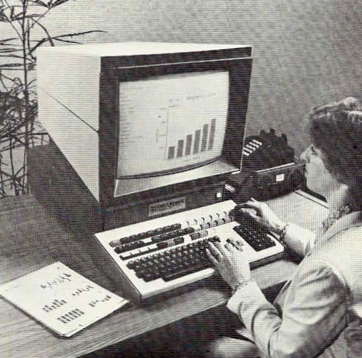
Business executives or their assistants can produce charts or graphs of current information simply and quickly by using the hand-held “mouse,” a rapid-response pointer device that helps to design visuals on the Execuchart screen. The color computer graphics system from Comshare can be learned in minutes. It produces highquality charts and graphs that readily depict business information on 35mm slides, color paper or transparencies.
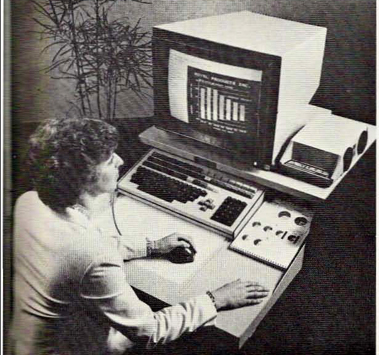
The console unit of Execuchart is a micro·computer based color graphics system whose use can be learned by anyone in minutes. Business information call be created andI displayed on a color screen by use of the hand-held “mouse,” a pointer-type device whose buttons command action via a cursor onl the screen. Output is in 35mm slide, color paper, or transparencies.
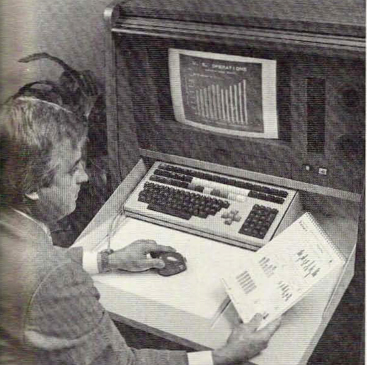
The Execuchart terminal communicates with the world-wide computer timesharing network of Comshare through telephone hook-up. The unit allows a user to create charts and graphs at his or her place of business. Production of slides, color (paper, or transparencies is via ” Comshare graphics output center or on-·site peripherals.
COMSHARE EMPLOYEE PHOTOS
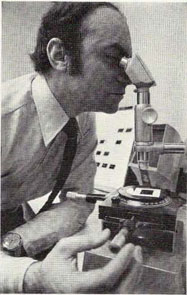
Ron Harrow, manager of Execuchart Graphic Output Center, examines a slide with high powered microscope.
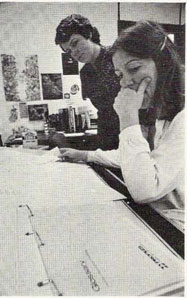
Marie Spinney (front) and Karen Clapham, designers, review layouts for a new volume of a client training book.


